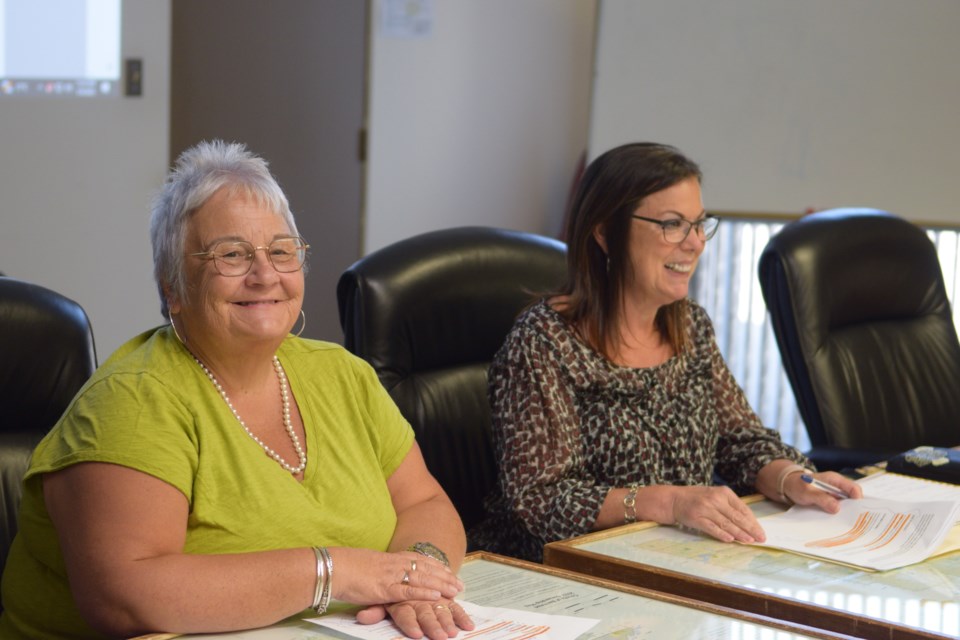BARRHEAD - Barrhead and District Family Community Support Services (FCSS) executive director Karen Gariepy had some good news for County of Barrhead councillors during the July 4 meeting, saying that overall food bank usage has been declining since the new year.
Gariepy and clients services worker Vernice Aitken were at the council meeting to give them their quarterly report.
She said in January, the food bank served 246 individuals, while in February, that number decreased to 201 and in March it dropped even further to 177. April saw a slight increase jumping to 181, before falling again to 161 in May.
Unfortunately, Gariepy noted, while the overall number of people in the Barrhead and Fort Assiniboine/Goose Lake region seeking assistance is trending downward, the number of seniors seeking help is rising.
Gariepy did not hazard a guess as to why the numbers are on the decline. Still, in past visits to Barrhead municipal councils, food bank staff have stated that senior usage is steadily rising due to inflationary issues, especially the cost of utilities and groceries.
She also noted that FCSS is gearing up for the Blue Suede Music Festival from July 28-30.
Gariepy noted that the Elvis tribute festival is a major fundraiser and food collection event for the Barrhead, Westlock and Morinville food banks, as well as the Ripple Connection Support Centre, and they are actively canvassing for volunteers.
Housing concerns
Gariepy reiterated her concerns about the lack of affordable housing in Barrhead and its impact on the community retaining new residents that come into the area as part of the Rural Renewal Stream (RRS). She first voiced her concerns at the June 26 Town of Barrhead council meeting. The RRS enables rural communities with less than 100,000 people to attract and retain immigrants by working with local employers and settlement-providing organizations to offer employment and support services, including housing, language training, health care, and education.
The stream requires that communities apply for designation through the province and have it for two years, with the option to extend for a third.
Barrhead (town and county) received its accreditation in early November.
According to county statistics, from November to the end of June, 23 employers have expressed interest, with 17 officially registering, with 64 positions posted through RRS. About 41 jobs have been filled through the program. Nine workers have arrived and are working and living in the community. However, most of the workers have yet to arrive.
"A lot of the workers (are coming from India),” Gariepy said. "And although we may be able to find temporary accommodation and boarding for the first year … what happens after that? I am afraid that after their year is up, they will move on to another community."
She noted that a recent needs assessment by the Barrhead and District Social Housing Association (BDSHA) shows that 525 families in the Barrhead municipalities need housing.
BDSHA CEO Tyler Batdorf, in a subsequent interview with the Leader, noted that the needs assessment statistics were just preliminary as their consultant is still tabulating all the information, saying the final assessment report is expected to be released in mid-August.
The other concern she has is the need for more available childcare spaces.
"If (the RRS workers) come in with families, how will we provide childcare? We are working with a family right now from another country, and she can't find a job because we can't find appropriate childcare for her," Gariepy said, noting that one woman has a special needs child. "These are the things that we will face once the candidates start arriving."
Coun. Walter Preugschas asked her about the 525 families with inadequate housing, saying he found it hard to believe the number was that high.
"It could be that they are living in apartments or homes that are too small for their needs or where multiple families are living in one home," she said. "It can also mean that the accommodations they are living in are unsuitable for living."
Reeve Doug Drozd interjected that when a community has the type of numbers BDSHA's need assessment report shows, it signals to the market that developers need to start building apartments or other high-density housing.
"Having said that, I can't remember the last time someone built an apartment building in Barrhead," he said. "Some developers have taken single-family homes and demolished them to create duplexes, but nothing of larger scale."



